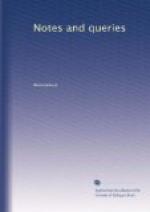{59}
“All dewile an duessem Dage,
Mit yuwer allen behage,
Under den HELLEN HIMMEL klar,
Ein fry Feld-gericht openbar;
Geheget BYM LECHTEN SONNENSHIN
Mit noechterm Mund kommen herin,
De toel ock is gesettet recht,
Dat maht befunden uprecht,
So sprecket Recht ane With und Wonne
Up Klage und Antwort, WEIL SCHIENT DIE
SONNE.”
I must refer to Morant, to Beckwith or Sir F. Palgrave, for the details of the ceremony of the Wardstaff, which it should appear was observed at least as late as the reign of Queen Elizabeth, but in Morant’s time it had long been neglected. In the hope that some of your antiquarian correspondents may be enabled to throw more light on this very curious custom, I will merely add, that Morant suggests that it is possible some elucidation of it might be found “in the Evidence House in Hatfield Church, where (he says) are a great number of writings relating to the priory and lordship.”
S.W. SINGER.
Jan 11. 1851.
[Footnote 3: aþied, cut.]
[Footnote 4: i.e. tally, or score.]
[Footnote 5: i.e. a rope with a bell appended.]
* * * * *
BALLAD ASCRIBED TO SIR C. HANBURY WILLIAMS.
Being engaged on a collection of fugitive pieces by wits of the last century, yet unprinted, I wish to take the opinion of your valuable correspondents as to the authorship of the enclosed piece. It has been pointed out to me in an album, dated at the beginning Feb. 14th, 1743; it occurs towards the end of the volume (which is nearly filled), without date, and signed C.H. Williams.
It is evidently not autograph, being in the hand which mainly pervades the book. Had Sir C.H. Williams been a baronet at the time, his title would doubtless have been attached to his name. I wish to know, first, at what date Sir C.H. Williams was born, became a baronet, and died? Secondly, is there any internal evidence of style that the ballad is by his hand? Thirdly, is there any clue as to who the fair and cruel Lucy may have been? And lastly, whether any of your correspondents have seen the thing in print before?
G.H. BARKER.
Whitwell, Yorkshire.
I.
“Lips like cherries crimson-juicy,
Cheeks like peach’s downy shades,
Has my Lucy—lovely Lucy!
Loveliest of lady’s maids!!!
II.
“Eyes like violet’s dew-bespangled,
Softly fringed deep liquid eyes!
Pools where Cupid might have angled
And expected fish to rise.




